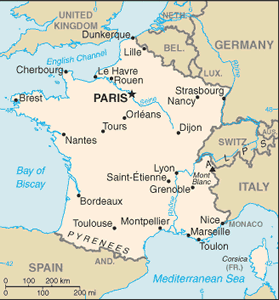The Geography of France
The Geography of France
French Geography
Location: metropolitan France: Western Europe, bordering the Bay of Biscay and English Channel, between Belgium and Spain, southeast of the UK; bordering the Mediterranean Sea, between Italy and Spain French Guiana: Northern South America, bordering the North Atlantic Ocean, between Brazil and Suriname Guadeloupe: Caribbean, islands between the Caribbean Sea and the North Atlantic Ocean, southeast of Puerto Rico Martinique: Caribbean, island between the Caribbean Sea and North Atlantic Ocean, north of Trinidad and Tobago Reunion: Southern Africa, island in the Indian Ocean, east of Madagascar
Geographic coordinates: metropolitan France: 46 00 N, 2 00 E French Guiana: 4 00 N, 53 00 W Guadeloupe: 16 15 N, 61 35 W Martinique: 14 40 N, 61 00 W Reunion: 21 06 S, 55 36 E
Map references: metropolitan France: Europe French Guiana: South America Guadeloupe: Central America and the Caribbean Martinique: Central America and the Caribbean Reunion: World
Area: total: 643,427 sq km; 547,030 sq km (metropolitan France) land: 640,053 sq km; 545,630 sq km (metropolitan France) water: 3,374 sq km; 1,400 sq km (metropolitan France) note: the first numbers include the overseas regions of French Guiana, Guadeloupe, Martinique, and Reunion
Area - comparative: slightly less than the size of Texas
Land boundaries: metropolitan France - total: 2,889 km border countries: Andorra 56.6 km, Belgium 620 km, Germany 451 km, Italy 488 km, Luxembourg 73 km, Monaco 4.4 km, Spain 623 km, Switzerland 573 km French Guiana - total: 1,183 km border countries: Brazil 673 km, Suriname 510 km
Coastline: total: 4,668 km metropolitan France: 3,427 km
Maritime claims: territorial sea: 12 nm contiguous zone: 24 nm exclusive economic zone: 200 nm (does not apply to the Mediterranean) continental shelf: 200 m depth or to the depth of exploitation
Climate: metropolitan France: generally cool winters and mild summers, but mild winters and hot summers along the Mediterranean; occasional strong, cold, dry, north-to-northwesterly wind known as mistral French Guiana: tropical; hot, humid; little seasonal temperature variation Guadeloupe and Martinique: subtropical tempered by trade winds; moderately high humidity; rainy season (June to October); vulnerable to devastating cyclones (hurricanes) every eight years on average Reunion: tropical, but temperature moderates with elevation; cool and dry (May to November), hot and rainy (November to April)
Terrain: metropolitan France: mostly flat plains or gently rolling hills in north and west; remainder is mountainous, especially Pyrenees in south, Alps in east French Guiana: low-lying coastal plains rising to hills and small mountains Guadeloupe: Basse-Terre is volcanic in origin with interior mountains; Grande-Terre is low limestone formation; most of the seven other islands are volcanic in origin Martinique: mountainous with indented coastline; dormant volcano Reunion: mostly rugged and mountainous; fertile lowlands along coast
Elevation extremes: lowest point: Rhone River delta -2 m highest point: Mont Blanc 4,807 m
Natural resources: metropolitan France: coal, iron ore, bauxite, zinc, uranium, antimony, arsenic, potash, feldspar, fluorspar, gypsum, timber, fish French Guiana: gold deposits, petroleum, kaolin, niobium, tantalum, clay
Land use: arable land: 33.46% permanent crops: 2.03% other: 64.51% note: French Guiana - arable land 0.13%, permanent crops 0.04%, other 99.83% (90% forest, 10% other); Guadeloupe - arable land 11.70%, permanent crops 2.92%, other 85.38%; Martinique - arable land 9.09%, permanent crops 10.0%, other 80.91%; Reunion - arable land 13.94%, permanent crops 1.59%, other 84.47% (2005)
Irrigated land: total: 26,190 sq km; metropolitan France: 26,000 sq km (2003)
Natural hazards: metropolitan France: flooding; avalanches; midwinter windstorms; drought; forest fires in south near the Mediterranean overseas departments: hurricanes (cyclones); flooding; volcanic activity (Guadeloupe, Martinique, Reunion)
Environment - current issues: some forest damage from acid rain; air pollution from industrial and vehicle emissions; water pollution from urban wastes, agricultural runoff
Environment - international agreements: party to: Air Pollution, Air Pollution-Nitrogen Oxides, Air Pollution-Persistent Organic Pollutants, Air Pollution-Sulfur 85, Air Pollution-Sulfur 94, Air Pollution-Volatile Organic Compounds, Antarctic-Environmental Protocol, Antarctic-Marine Living Resources, Antarctic Seals, Antarctic Treaty, Biodiversity, Climate Change, Climate Change-Kyoto Protocol, Desertification, Endangered Species, Hazardous Wastes, Law of the Sea, Marine Dumping, Marine Life Conservation, Ozone Layer Protection, Ship Pollution, Tropical Timber 83, Tropical Timber 94, Wetlands, Whaling signed, but not ratified: none of the selected agreements
Geography - note: largest West European nation


